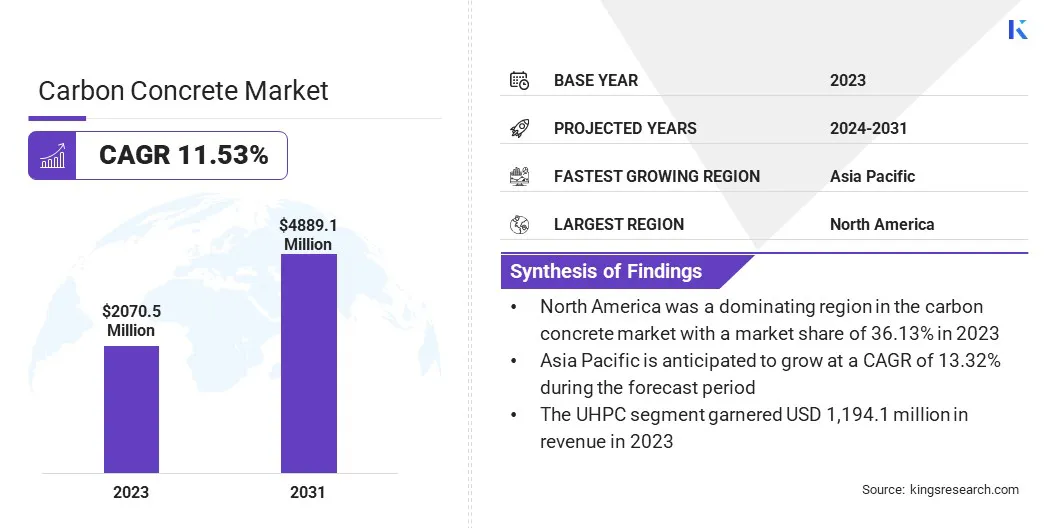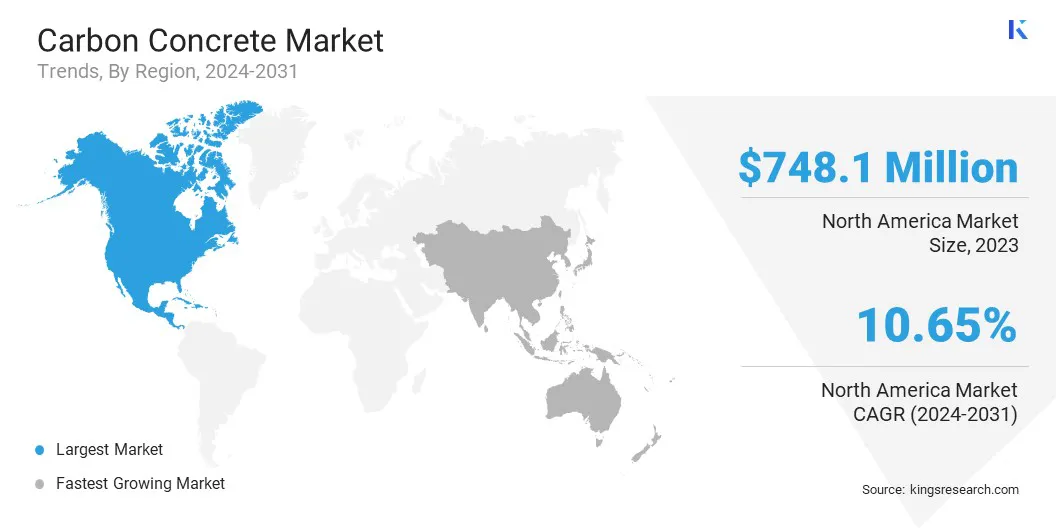Carbon Concrete Market Size
The global Carbon Concrete market size was valued at USD 2,070.5 million in 2023 and is projected to grow from USD 2,278.2 million in 2024 to USD 4,889.1 million by 2031, exhibiting a CAGR of 11.53% during the forecast period. Carbon concrete is lighter than traditional concrete, easier to install, and reduces labor cost, making construction processes easier. In the scope of work, the report includes product/services offered by companies such as CarbonCure Technologies Inc., Solidia Technologies, HOLCIM, Cemex S.A.B. de C.V., CARBOCON GMBH, CarbiCrete, Blue Planet Systems, Ecocem, LAFARGE, and Sika AG.
There has been an increase in the demand for sustainable construction practices due to strict government regulations and rising environmental concerns. Carbon concrete is expected to be a vital component of these practices due to its, low carbon emissions and higher durability leading to the carbon concrete market growth. Rapid infrastructure development in the past few years has driven the demand for traditional concrete. Carbon concrete is a sustainable alternative to traditional concrete as it is light in weight which makes its transportation, handling, and installation easy.
- As per the Global Cement and Concrete Association, major cement and concrete producers are aiming to produce carbon neutral concrete by 2050. This move will help decarbonize the cement and concrete industry and provide net zero concrete globally.
Carbon concrete, a sustainable construction material, is created by mixing concrete with carbon fibers and carbon bars. These reinforcing elements form a mesh-like, textile-like structure within the concrete, significantly increasing its tensile strength. Currently the trends witnessed by the global construction industry mainly focus on energy efficiency, (through use of renewable energy, smart building technologies and sustainable construction materials); material selection (eco-friendly materials and recycled materials); and waste reduction and recycling. Favorable initiatives by concrete and cement producers and government rules and regulations are also expected to positively impact the market.

Analyst’s Review
Due to continuous infrastructure development globally, cement manufacturing has seen a growing trend. According to the World Economic Forum in 2024, the CO2 emissions from cement manufacturing processes accounted for 6% of the overall emissions. The continuation of this trend in the construction sector is anticipated to have an adverse effect on the environment. Due to such concerns, there has been a shift in the strategy of global concrete manufacturers, where they are using the latest carbon utilization technology to produce sustainable carbon concrete to meet the increased demand as well as reduce its harmful environmental effects. Initially, the cost of production for carbon concrete is high due to its complex production process, customization, and limited experienced professionals in this field. However, once the company scales up its production and achieves economies of scale, the overall cost of production automatically reduces which in turn brings down the cost of carbon concrete.
Carbon Concrete Market Growth Factors
Few important drivers for the growth of carbon concrete market are rapid urbanization, infrastructure development, and increase in sustainable practices. Due to growing population, the demand for constructing new as well as revamping existing infrastructural projects such as bridges, buildings, educational institutions, and hospitals, has gained pace. The above applications can be benefitted by carbon concrete, which can promote green and sustainable construction with its and easy transportation and installation features.
- For instance, in 2023, Indianapolis International Airport used the Federal Aviation Administration (FAA)-approved carbon sequestration technology to produce carbon concrete, which was used to revamp their concrete pavement. Carbon concrete was also used to build two new bridges in Kreuzau, Germany in 2023. This bridge was specifically designed for pedestrians, cyclists, and maintenance vehicles.
In 2023, the governments of Canada, Germany, United Kingdom, and United States, member countries of Industrial Deep Decarbonization Initiative (IDDI), committed to producing low carbon cement and concrete, and at the same time, set emissions threshold to achieve net zero emissions in public buildings. As per the United Nations Industrial Development Organization (UNIDO), IDDI, a ministry led by UNIDO, will help in setting up an environment for the decarbonization of heavy industries starting with steel and cement.
The growth of the carbon concrete market is evident, however, it comes with its own set of challenges such as lack of awareness, unavailability of raw materials due to supply chain restrictions, and competition from established traditional cement manufacturers. These challenges can be resolved with favorable government initiatives, development of robust supply chain, and creating awareness and importance of carbon concrete through various programs.
Carbon Concrete Industry Trends
The two main market trends that could benefit the carbon concrete market are the development of more net-zero buildings and the increasing need for light weight construction materials. Net zero buildings are structures that produce as much energy as they consume, creating a self-sustaining energy system. Carbon concrete is easy to transport being light weight in nature. In addition, due to its versatile nature, it allows users to achieve sustainability and reduce carbon footprint. Furthermore, low carbon concrete flooring provides better heat retention that reduces the need for heating and cooling systems.
The combination of carbon fiber fabrics or bars and fine grained concrete imparts carbon concrete its light weight. Another benefit of carbon concrete is that it is environmentally sustainable due to lower greenhouse emissions during its production. Additionally, it is also corrosion resistance which reduces the need for concrete cover and resources.
Segmentation Analysis
The global market has been segmented based on end-use industry, type, and geography.
By End-use Industry
Based on end-use industry, the carbon concrete market is segmented into construction, government and others. The CAGR for the forecast period, 2024-2031, is expected to remain the highest for the Government segment at 12.01%. This high growth can be attributed to increased government initiatives and efforts to reduce carbon emissions from heavy carbon emitting industries.
- In 2024, the U.S. Department of Energy's Industrial Efficiency and Decarbonization Office announced plans to establish a Cement and Concrete Center of Excellence. This center aims to accelerate the development and adoption of low-carbon cement and concrete technologies through collaborative efforts with academia, national labs, government agencies, and corporations.
By Type
Based on type, the market has been divided into Carbon Fiber Reinforced Concrete (CFRC) and Ultra-High Performance Concrete (UHPC). In 2023, the UHPC segment led the market with a valuation of USD 1,194.1 million. When comparing CFRC to UHPC, UHPC captures a bigger market due to its high compressive strength and higher resistance to cracking, abrasions, and corrosions. UHPC is typically used to increase the life of bridge decks, flyovers and industrial floors.
- In 2024, WSP, which served as a designer for the Delaware Memorial Bridge UHPC Deck Rehabilitation Project, used UHPC as it is sustainable and a high performing substitute to traditional concrete.
Carbon Concrete Market Regional Analysis
Based on region, the global market has been classified into North America, Europe, Asia-Pacific, MEA, and Latin America.

North America was a dominating region in the carbon concrete market with a market share of 36.13% in 2023. This can be attributed to robust investment in research and development and various government initiatives.
- In 2023, Heidelberg Materials opened Canada's first full-scale carbon capture and storage facility at its Edmonton plant in Alberta. The new facility, slated to become operational in 2026, will capture over 1 million tons of CO2 annually.
Asia-Pacific is poised for significant growth over the forecast period at a CAGR of 13.32%. This region is facing a construction boom, with extensive government investments in infrastructure projects for building highways, bridges, and buildings. At the same time, the government is also providing funding, grants, and regulations to support the market. For instance, Neustark a Swiss carbon removal provider, raised funding for the expansion of its company in North America, Europe, and Asia Pacific.
Competitive Landscape
The global carbon concrete market report provides valuable insights with an emphasis on the fragmented nature of the industry. Prominent players are focusing on several key business strategies such as partnerships, mergers and acquisitions, product innovations and joint ventures to expand their product portfolio and increase their market shares across regions. Strategic initiatives, including investments in R&D activities, establishment of new manufacturing facilities, and supply chain optimization, could create new opportunities for the market growth.
List of Key Companies in Carbon Concrete Market
Key Industry Developments
- November 2024 (Partnership): Betolar and Saudi Readymix (SRMCC), a leading manufacturer and supplier of concrete products in Saudi Arabia, have partnered to develop two advanced low carbon concrete formulations. This collaboration would help fulfill Saudi Arabia’s growing infrastructure need with sustainable solutions.
- November 2024 (Partnership): Titan Group, a leading international cement producer, partnered with Ecocem, a provider low carbon cement technology. This partnership will create a new product by replacing a substantial amount of clicker with supplementary cementitious materials (SCMs).
The global carbon concrete market has been segmented:
By End-use Industry
- Construction
- Government
- Others
By Type
- Carbon Fiber Reinforced Concrete (CFRC)
- Ultra-High Performance Concrete (UHPC)
By Region
- North America
- Europe
- France
- UK
- Spain
- Germany
- Italy
- Russia
- Rest of Europe
- Asia-Pacific
- China
- Japan
- India
- South Korea
- Rest of Asia-Pacific
- Middle East & Africa
- GCC
- North Africa
- South Africa
- Rest of Middle East & Africa
- Latin America
- Brazil
- Argentina
- Rest of Latin America


